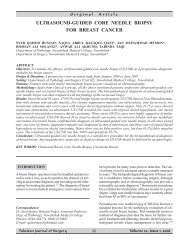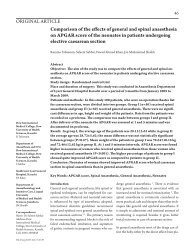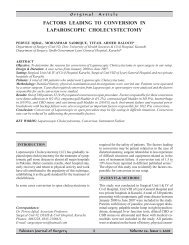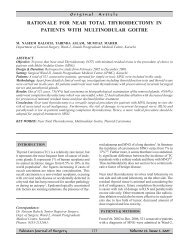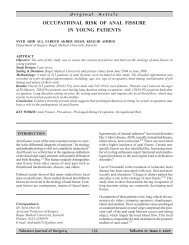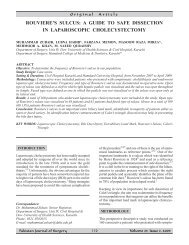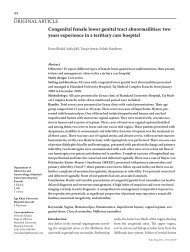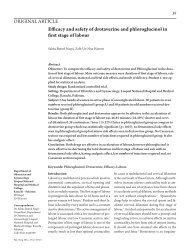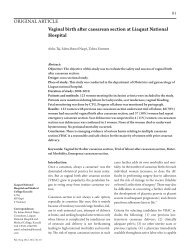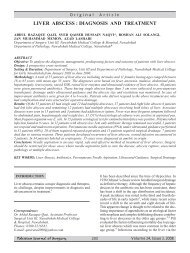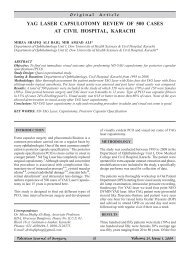Laparoscopic repair in perforated peptic ulcer
Laparoscopic repair in perforated peptic ulcer
Laparoscopic repair in perforated peptic ulcer
Create successful ePaper yourself
Turn your PDF publications into a flip-book with our unique Google optimized e-Paper software.
<strong>Laparoscopic</strong> <strong>repair</strong> <strong>in</strong> <strong>perforated</strong> <strong>peptic</strong> <strong>ulcer</strong>In open procedure after thorough peritoneallavage, perforation is closed with or with outre<strong>in</strong>forcement of omental patch. Few surgeonsdur<strong>in</strong>g emergency <strong>peptic</strong> <strong>ulcer</strong> surgery haveadequate experience with selective vagotomy,therefore it is recommended that suture oromental flap is followed by medical treatment<strong>in</strong>clud<strong>in</strong>g elim<strong>in</strong>ation of H pylori if present otherwisema<strong>in</strong>ta<strong>in</strong> on proton pump <strong>in</strong>hibitor. 13<strong>Laparoscopic</strong> treatment of PPU was first reportedby Mouret et al <strong>in</strong> 1989 14 followed soon afterby Nathanson et al. 15 The recognized advantagesof laparoscopy are decreased postoperative pa<strong>in</strong>,early mobilization, early return to work andlower complication rate, make this treatmentmodality attractive to many surgeons all over theworld. Nonetheless there are relative contra <strong>in</strong>dicationswhich <strong>in</strong>clude elderly patients, cardiacpathology, chronic respiratory <strong>in</strong>sufficiency,obesity, cirrhosis and sever coagulopthies.There are variety of techniques to close the perforationlaparoscopically such as <strong>in</strong>tra and extracorporeal knots, hold<strong>in</strong>g omental path with fibr<strong>in</strong>glue or seal<strong>in</strong>g with gelat<strong>in</strong> etc. The aim ofthis study was to evaluate the efficacy and safetyof laparoscopic closure of PPU and also identifythose patients who are not suitable for this treatmentmodality.Materials and Methods:Total 25 patients were recruited for this prospectivestudy. This study was conducted from July2007 to June 2010 and all patients were attemptedfor laparoscopic closure of PPU <strong>in</strong> SurgicalUnit 3, PMCH and private hospital. The diagnosiswas based on sudden onset of severe, sharpabdom<strong>in</strong>al pa<strong>in</strong> present <strong>in</strong> epigastrium or generalizedpa<strong>in</strong> accompanied by nausea and vomit<strong>in</strong>g.On exam<strong>in</strong>ation obvious distress, tachycardia,tachypnoea along with abdom<strong>in</strong>al signs oftenderness guard<strong>in</strong>g and rigidity. Patients werealso asked about past history of PUD, <strong>in</strong>take ofNSAIDS, alcohol and smok<strong>in</strong>g. Rout<strong>in</strong>e <strong>in</strong>vestigationssuch as Blood CP, serum amylase, bloodurea, chest x-ray <strong>in</strong> erect posture and US werealso performed to reach the diagnosis. Exclusioncriteria for this procedure were extensiveperitonitis, upper abdom<strong>in</strong>al <strong>in</strong>cision, patients174presented 24 hours after perforation and shock.Parameters observed were operative time, <strong>in</strong>traoperative and post operative complication, pa<strong>in</strong>management, hospital stay and rate of conversionto open surgery. Once the diagnosis of PPUwas established patient resuscitated aggressivelybefore the operation. Laparoscopy performedvia 4 ports one port <strong>in</strong> the umbilicus for camera,2 work<strong>in</strong>g ports at right and left upper abdomenand one port <strong>in</strong> the epigastrium to retract thequadrate lobe of the liver. 2-0 vicryl used for closureof perforation and omental patch anchoredover the perforation with vicryl stitche to sealthe perforation completely, thorough abdom<strong>in</strong>allavage performed with sal<strong>in</strong>e.Results:In 25 consecutive patient’s laparoscopic closureof <strong>perforated</strong> <strong>peptic</strong> <strong>ulcer</strong> (PPU) attempted.There were 20 (80%) patients males and 5(20%)females (Figure-1). The mean age was 42.2(22-75) years (Figure-2). The mean operativetime was 75 (55 to 110) m<strong>in</strong>utes. Patients havestarted oral <strong>in</strong>take from third day. The mean postoperative hospital stay was 5-8 days. In 5(16%)24%20%20%16%24%80%Figure 1: Sex Distribution (n= 25)16%Figure 2: Age Distribution (n= 25)FemaleMale65-7555-6545-5535-4525-35Pak J Surg 2011; 27(3): 173-176



